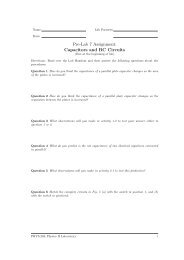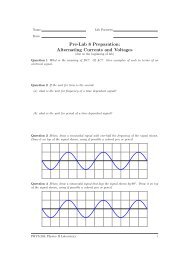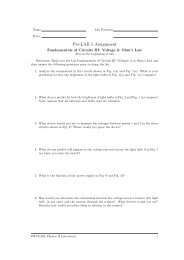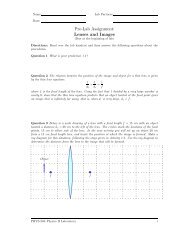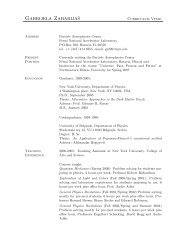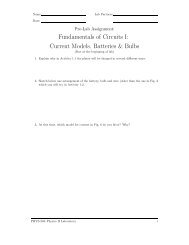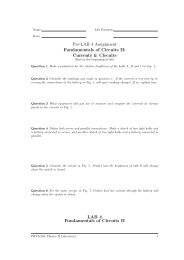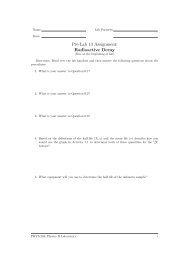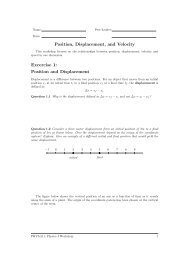Pre-LAB 6 Preparation: Fundamentals of Circuits IV: Kirchhoff's ...
Pre-LAB 6 Preparation: Fundamentals of Circuits IV: Kirchhoff's ...
Pre-LAB 6 Preparation: Fundamentals of Circuits IV: Kirchhoff's ...
- No tags were found...
You also want an ePaper? Increase the reach of your titles
YUMPU automatically turns print PDFs into web optimized ePapers that Google loves.
<strong>Fundamentals</strong> <strong>of</strong> <strong>Circuits</strong> <strong>IV</strong>: Kirchh<strong>of</strong>f’s Circuit Rules v 0.3Activity 1.3: Reading Resistor Codes and Measuring ResistanceStep 1: Choose three resistors <strong>of</strong> different values, and read their color codes. Record theresistances and tolerances in the first two columns <strong>of</strong> Table ??.R from code (Ω) Tolerance from code Measured R (Ω) Percent discrepancyTable 2: Resistance, Tolerance & AccuracyStep 2: After setting the multimeter to measure ”resistance”, measure the resistance <strong>of</strong> eachresistor, and enter the values in the table in the column labeled ”Measured R.”Step 3: Determine the percentage difference between the coded value <strong>of</strong> each resistor and thevalue you measured. In general, percentage difference is given by the expressionPercent difference =Accepted value - Experimental value∣ Accepted value ∣ ×100Question 1.5 How do the values <strong>of</strong> the resistors measured with the multimeter compareto the values indicated by the color code? Assuming that your measured values are correct,are the values indicated by the color code within the stated tolerance?Investigation 2:Series and Parallel Combinations <strong>of</strong> ResistorsSeveral resistors can be wired in series to increase the effective length and in parallel to increasethe effective cross sectional area <strong>of</strong> the resistive graphite, as shown in Fig. 6.You will next explore the equivalent resistances <strong>of</strong> various combinations <strong>of</strong> resistors connectedin series or in parallel. You will need the following:• Three 56Ω resistors• 22Ω and 68Ω resistors• digital multimeter• Pasco circuit board• connecting wiresPHYS-204:Physics II Laboratory 6





